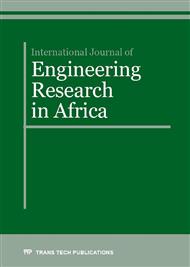[1]
Tan, P.N., Steinbach, M., and Kumar, V., Introduction to data mining, Addison Wesley Publishers, (2006).
Google Scholar
[2]
A. Kejariwal, Big Data Challenges : A program optimization Perspective, International Conference on cloud and Green Computing ( 2012) 202-207.
DOI: 10.1109/cgc.2012.17
Google Scholar
[3]
R. Agrawal ,T. Imielinski and A. Swami, Mining Association Rules between sets of Items in large Databases". In Proc. 1993 ACM-SIGMOD, Int. Conf. Management of Data (SIGMOD, 93), pp.207-216 Washington , DC, May (1993).
DOI: 10.1145/170036.170072
Google Scholar
[4]
V. Pudi. Data Mining: Concepts and Techniques, Oxford University Press, Jan-(2009).
Google Scholar
[5]
G. Kaur, S. Aggarwal, Performance Analysis of Association Rule Mining Algorithms, International Journal of Advanced Research in Computer Science and Software Engineering, 3-8 (2013) 856-858.
Google Scholar
[6]
S. Ghosh, S. Biswas , D. Sarkar ,P.P. Sarkar , Mining Frequent Itemsets Using Genetic Algorithm, International Journal of Artificial Intelligence & Applications, 1-4 (2010) 133-143.
DOI: 10.5121/ijaia.2010.1411
Google Scholar
[7]
C. Chai, B. Li, A Novel Association Rules Method Based on Genetic Algorithm and Fuzzy Set Strategy for Web Mining, Journal of Computers, 5-9 ( 2010) 1448-1455.
DOI: 10.4304/jcp.5.9.1448-1455
Google Scholar
[8]
W. Soto , A. Olaya-Benavides, A Genetic Algorithm for Discovery of Association Rules. In Computer Science Society (SCCC) ( 2011) 289-293.
DOI: 10.1109/sccc.2011.37
Google Scholar
[9]
P. Ashthana, A. Singh, D. Singh, A Survey on Association Rule Mining Using Apriori Based Algorithm and Hash Based Methods, International Journal of Advanced Research in Computer Science and Software Engineering, 3-7( 2013) 599- 603.
Google Scholar
[10]
D. W Cheung , J. Han, V. T. Ng , C. Y. Wong, Maintenance of discovered association rules in large database: An incremental updated approach. The 12th IEEE International Conference on Data emerging ( 1996) 106-114.
DOI: 10.1109/icde.1996.492094
Google Scholar
[11]
D.W. Cheung, S.D. Lee , B. Kao, A general incremental technique for maintaining discovered association rules. In Proc of the fifth international conference on database system for advanced application, Melbourne, Australia ( 1997) 185-194.
DOI: 10.1142/9789812819536_0020
Google Scholar
[12]
Z. Zhou , C. I. Ezeife,. A Low-Scan Incremental Association Rule Maintenance Method. Proceedings of the 14th Canadian Conference on Artificial Intelligence. (2001).
DOI: 10.1007/3-540-45153-6_3
Google Scholar
[13]
S. Thomas, S. Badagola, K. A Isabh , S. Ranka, An efficient algorithm for updating large items with pruning. Proc of third ACM SIGKDD international conference on knowledge discovery on data mining ( 1997) 263-266.
Google Scholar
[14]
N.L. Sarda, N.V. Srinivas, An Addaptive Algorithm for Incremental Mining of Association Rules. Proceedings of Ninth Int. Workshop on Database and Expert SysteM (1998) 240-248.
DOI: 10.1109/dexa.1998.707409
Google Scholar
[15]
N.S. Ayan, A.U. Tansel , M. E Arkun, An efficient algorithm for updating large items with pruning. Proc of fifth ACM SIGKDD international conference on knowledge discovery on data mining ( 1999) 287-291.
DOI: 10.1145/312129.312252
Google Scholar
[16]
A. Das, D.K. Bhattacharya, Rule Mining for Dynamic Databases, Australasian Journal of Infortion Systems, 13-1( 2005) 19-39.
Google Scholar
[17]
R. Feldman, Y. Aumanm, O. Lipshtat, Border : An Efficient Algorithm for Association Generation in Dynamic Databases, Journal of Intelligent Information Systems (1999) 61-73.
Google Scholar
[18]
Z. Meng, B. Shao, M. Jiang, An Algorithm of Dynamic Assocition Rule Based on Sliding indows, Proceeding of Int. Conference on Comptational Intelligence and Security ( 2010) 51-54.
Google Scholar
[19]
W Cheung , O. R. Zaiane, Incremental Mining of Frequent Patterns without Candidate Generation or Support Constraint. Proceedings of the 7th International Database Engineering and Application Symposium ( 2003) 111- 116.
DOI: 10.1109/ideas.2003.1214917
Google Scholar
[20]
Leung, Carson Kai-Sang, Quamrul I. Khan, Tariqul Hoque, CanTree: A Tree Structure for Efficient Incremental Mining of Frequent Patterns", in Proceedings of the Fifth IEEE International Conference on Data Mining (ICDM'05), (2005).
DOI: 10.1109/icdm.2005.38
Google Scholar
[21]
T. P. Hong, J. W. Lin, Y. L. Wu, A Fast Updated Frequent Pattern Tree, in Proc of IEEE International Conference on Systems, Man, and Cybernetics, Taipei, Taiwan ( 2006) 2167-2172.
DOI: 10.1109/icsmc.2006.385182
Google Scholar
[22]
M. Adnan, R. Alhaji, K. Barker, Alternative Method for Incrementally Constructing te FP-Tree, Proceeding of International IEEE Conference Intelligent Systems. (2006) 494-499.
DOI: 10.1109/is.2006.348469
Google Scholar
[23]
C. Lin, T.P. Hong, W.H. Lu, The Pre-FUFP algorithm for Incremental Mining, Exper System with Applications, doi10. 1016/j. eswa. 2008. 03. 014 ( 2008).
Google Scholar
[24]
W. Jian, L.X. Ming, A novel Algorithm for dynamic Mining of Association Rules, Proceeding of Workshop on Knowledge Discovery and Data Mining ( 2008) 94-99.
DOI: 10.1109/wkdd.2008.32
Google Scholar
[25]
S. Shan, X. Wang, M, Sui, Mining Association Rules: A Continuous Incremental Updating Technique, Proceeding of International Conference on Web Information Systems and Mining ( 2010) 62-66.
DOI: 10.1109/wism.2010.39
Google Scholar
[26]
X. Wei, Y. Ma, F. Zhang, M. Liu, W. Shen, Incremental FP-Growth Mining Strategy for Dynamic Threshold Value and Database Based on MapReduce, Proceeding of IEEE 18th International Conference on Computer Supported Cooperative work in Design ( 2014) 271- 276.
DOI: 10.1109/cscwd.2014.6846854
Google Scholar
[27]
S. Kurazumi, T. Tsumura, S. Saito, H. Matsuo, Dynamic Processing slots scheduling for I/O intensive jobs of Hadoop MapReduce, Proceeding of the 3rd International Conference on Networking and Computing ( 2012) 288-292.
DOI: 10.1109/icnc.2012.53
Google Scholar
[28]
J.S. Park, M.S. Chan and P.S. Yu. An effective hash-based algorithm for mining association rules". In Proc. 1995 ACM-SIGMOD Int. Conf. management of Data (SIGMOD, 95), pp.175-186, San Jose, CA, May (1995).
DOI: 10.1145/568271.223813
Google Scholar
[29]
J. Han, J. Pei and Y Yin. Mining frequent patterns without candidate generation". In Proc. 2000 ACM-SIGMOD Int. Conf. Management of Data ( SIGMOD, 00), pp.1-12, Dallas, TX, May (2000).
DOI: 10.1145/335191.335372
Google Scholar
[30]
B. J. Park, Efficient Tree-based Discovery of Frequent Itemsets, International Journal of Multimedia and Ubiquitous Engineering Vol. 7, No. 2, pp.383-388, April, (2012).
Google Scholar
[31]
S. Patel , K. Kotecha, Incremental Frequent Pattern Mining using Graph based approach, International Journal of Computers & Technology, 4-2 ( 2013) 731-736.
DOI: 10.24297/ijct.v4i2c2.4191
Google Scholar


